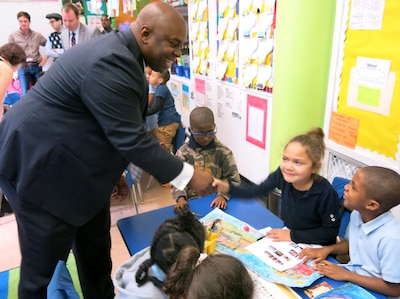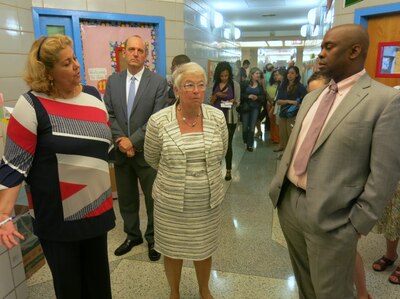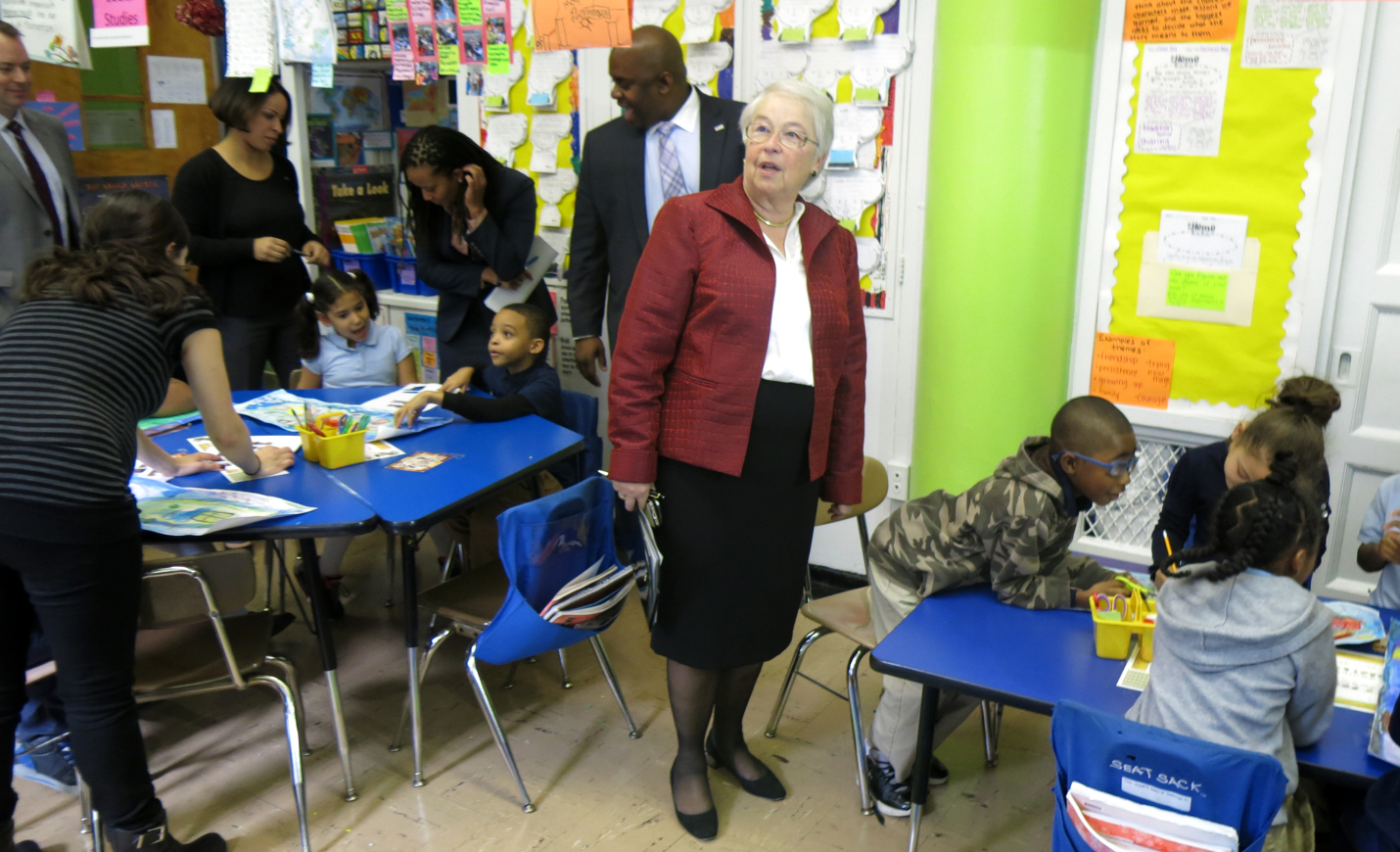When Mayor Bill de Blasio revealed his plan last month to rescue 94 of the city’s lowest performing schools by converting them into service-rich hubs known as “community schools,” groups that had spent years lobbying the city for such schools lauded the idea.
But behind the scenes, some of those same supporters expressed doubts.
They bubbled up Wednesday when members of a community schools advisory board met with Chancellor Carmen Fariña and other top city officials. Some of the City Hall-appointed members peppered the officials with questions about how the turnaround plan will work, and several walked out after officials stopped taking feedback, attendees said.
Unlike a smaller program de Blasio launched earlier this year that asked eager principals to apply for money to create community schools, the turnaround plan compels leaders of struggling schools to adopt that approach regardless of whether they appear willing or able. And the schools will be required to boost students’ academic performance within a few years, even though community schools’ record on that front is mixed and the city has offered few details about how it will help them improve instruction.
Those points are nagging at people who want the mayor’s plan to work, but worry what will happen to the community schools movement if it falls short. Megan Hester, an advisory board member who works for the Annenberg Institute for School Reform, said her concerns crept in just hours after the mayor’s speech last month.
“When I was laying in bed that night I thought, ‘This is going to be amazing, or it’s going to be the death of community schools,’” said Hester, who provides support to the Coalition for Educational Justice, an alliance of advocacy groups that has been an outspoken champion of community schools. “Because if they don’t pull off the academic piece, it’s going to be blamed on the community school model.”
An ambitious “gamble”

The turnaround plan, dubbed “school renewal,” will connect the schools with agencies that will bring in physical and mental health services for students, after-school programs, tutoring, and perhaps job training or housing assistance for parents. The city will also provide teacher training and principal mentoring, a curriculum review, data-tracking systems, and an extra hour of learning time each day, officials said. In return, the schools must show that students have made academic gains within three years or they could face leadership changes or even closure.
The idea of saturating schools with services that attend to students’ personal needs goes back decades, and has been embraced by political leaders from President Obama and Gov. Cuomo down to the City Council. And it has been tried in districts across the country, including Cincinnati, where the city teachers union has taken de Blasio and other officials to visit.
Still, de Blasio’s plan stands out for its ambition: When the schools that applied are added to the struggling ones, the administration is now working to launch 128 new community schools — by some counts, quadrupling the number of such schools in the city.
It is also rare for a district to make the community schools model the centerpiece of its school-turnaround strategy. Trying to convert many low-performing schools into community schools all at once could prove especially challenging, and that has worried some of the very people who most want the plan to succeed, according to interviews with more than 20 advocates, educators, and experts.
Nicole Mader, a researcher who advised education department officials this summer as they crafted their plan for the 45 voluntary community schools, said it was “a total surprise” to see the city extend that model to the 94 struggling schools. (Eleven schools are in both groups.)
“We had conversations with them about how hard it would be to establish a community school at schools that are failing on many fronts,” said Mader, an education policy analyst at the Center for New York City Affairs at the New School. “It was a crazy gamble to put so much reliance on this model before the model as whole has been proven to work” at this scale in New York, she said.
The academic component
The biggest question looming over the community-schools-as-turnaround plan is whether it will improve the schools’ academics. Advocates and city officials both agree that flooding schools with social workers and healthcare providers can remove obstacles that keep students from learning and teachers from focusing on instruction, but unless the schools’ academic programs improve too, students are unlikely to make big gains.
In fact, several city schools that have used the community-school model for years still grapple with low test scores and graduation rates, such as P.S. 50 in East Harlem, which has been a Children’s Aid Society-partnered community school for 14 years but still landed on the renewal-schools list. The principal of Boys and Girls High School in Bedford-Stuyvesant, who recently resigned, brought in mentors from Good Shepherd Services last fall and a health clinic as part of a years-long effort to create a community school by partnering with outside groups and bringing in services. But the school’s curriculum and instruction still had flaws, evaluators concluded last year, and it remains on the state’s lowest-ranked list.
City officials argue that the new community schools will get more funding and support than those created in the past, along with academic interventions like longer days and teacher training. Jane Quinn, director of the Children’s Aid Society’s National Center for Community Schools, said she “totally supports” the city’s community schools push, but is awaiting more specifics about the academic components.
“What is the plan for helping these 94 schools with the instructional side?” she said. “I think it needs to be forthcoming pretty soon.”
Promising but mixed results

City officials point to other districts that have achieved impressive academic gains through a community schools approach, such as Boston and Tulsa, to make the case for their plan. However, those models differ from New York’s in important ways.
Boston had its community schools program in place for nearly a decade before it spread the model to a handful of state-designated struggling schools, whose principals were also replaced. And in Tulsa, principals take multiple years to study the model and plan before becoming a community school — a much longer timeline than the one planned for New York.
In general, research on whether community schools improve student academic performance is promising but mixed, said Kristin Anderson Moore, a senior scholar at the research center Child Trends who has analyzed the model.
“There are studies that find positive impacts,” she said. “But when you look at a lot of them, you also find others that don’t.”
Driving the train
Another unknown is whether principals of the low-performing schools — who may want more support, but didn’t opt into the program or know the city’s plans until its announcement — will embrace the community schools model or be able to pull it off.
Experts note that running a community school involves much more than choosing from a menu of support programs. The city will pay for site coordinators at each school, but principals still must help identify the school’s needs and find the right providers. Experienced principals then weave those extra services seamlessly into the school by, for example, inviting after-school workers to teacher trainings and parents to high-level meetings.
Mark House, principal of the Community Health Academy of the Heights, a Washington Heights community school, said that even with a full-time site coordinator he spends at least one-fifth of every week dealing with the program’s logistics. To run a single after-school yoga class for parents and students, for instance, he had to raise money, handle liability matters, coordinate with the school custodian, and make sure yoga mats were available.
“It’s that kind of stuff over and over again,” he said. “It’s a very significant amount of time.”
Deputy Mayor Richard Buery, who is overseeing the community schools efforts, said he is confident that educators at the 94 schools will welcome the model and the extra resources it offers, and he emphasized that the full turnaround plan pairs academic interventions with support services. Still, he said that launching the plan has been akin to “building the track while you drive the train.”
“Our job is to keep pushing it,” he said, “so that teachers can come to school with the skills and readiness to teach and students come with a readiness to learn.”
Update: This article has been updated to better describe the community-school efforts at Boys and Girls High School and its academic struggles.

